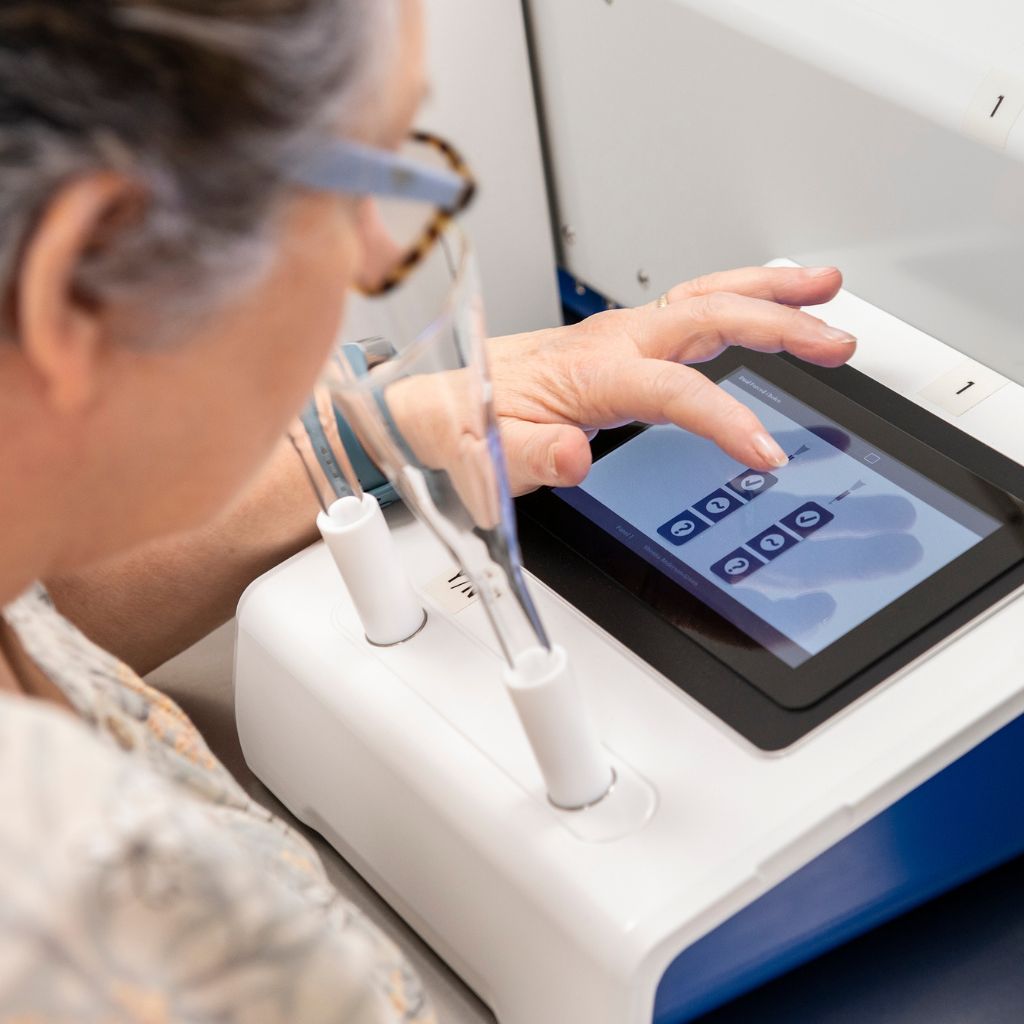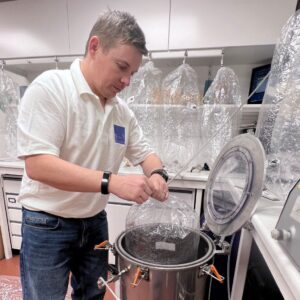EVERYTHING YOU NEED TO KNOW ABOUT OLFACTOMETRY

WHAT IS OLFACTOMETRY?
Simply put, olfactometry is the process of measuring the concentration and intensity of odour. As odour consultants, many clients come to us looking for this service. Generally, we refer to it as odour testing, and it’s the bread and butter of what we do here at Silsoe Odours. Olfactometry is often used for environmental monitoring of industrial or agricultural operators, where controlling odorous emissions is important for environmental and health reasons. Regulatory agencies and industries may use it to;
- assess an operator’s impact on the surrounding community
- evaluate odour nuisance complaints
- determine whether odour control measures are effective
- identify and mitigate sources of odour emissions
Olfactometry uses human assessors, because the nose remains the most sensitive and accurate odour-detection instrument.
HOW DOES OLFACTOMETRY WORK?

Lab Operator, Stephen, dilutes an odour sample
At Silsoe Odours, we use carefully selected, screened and trained odour panel members to conduct olfactometry testing. Our laboratory operator dilutes samples of air containing odour with clean air to achieve specific concentrations. They then present these samples to the odour panel. Using a process of forced choice, panel members detect and rate the intensity and character of the odour. From their responses, we can calculate the concentration of the odour in the sample. We also use olfactometry in conjunction with chemical analysis to assess a sample’s odour profile.
The process of olfactometry typically involves the following steps:
WHY DO YOU NEED AN OLFACTOMETER?
The olfactometer is a scientific instrument. Its primary purpose is to control the delivery of an odour sample to our human assessors. Using the olfactometer, we can measure the concentration of an odour sample with a high degree of precision and accuracy. Not only does this help us assess the odour, but it also means we can manage the safety of our panellists.
While olfactometers are critical to our work as odour consultants, they are also widely used in other fields, including psychology, neuroscience, medical research and product testing.
HOW CAN ODOUR IMPACT HUMAN HEALTH?
A volatile organic compound (VOC) is an organic chemical that evaporates easily at room temperature, allowing it to enter the air as a gas. VOCs are produced both naturally and through human activity. Many have a strong odour that can be detected at low levels. VOCs also contribute to air pollution and can cause health issues. For example, one such VOC is hydrogen sulphide (H₂S) – a common component of the samples we collect and analyse. H₂S is a colourless, flammable gas with a characteristic rotten egg odour. Exposure can lead to eye, nose and throat irritation, headaches, nausea and dizziness. In very extreme circumstances, exposure can cause death. This chart explains the possible health effects associated with different exposure levels.
HOW DO WE KEEP ODOUR PANEL MEMBERS SAFE?
Our odour consultants and panel members can potentially be exposed to odorants. With this in mind, we have strict precautions to ensure our staff’s safety. These include:
Personal Protective Equipment (PPE)
Our consultants must wear appropriate PPE when they collect odour samples. For example, gloves, eye protectors and personal gas sensors to detect hydrogen sulphide and ammonia. In this manner, they can protect themselves from exposure to chemicals and other hazardous materials.
Hydrogen Sulphide Testing
We are careful to take precautions to make sure the team aren't exposed to dangerous levels of hydrogen sulphide (H₂S), from the point where we collect samples right through to testing in the olfactometry lab. Primarily, we use a Jerome, which is a type of portable gas detector. We use it to check if the sample is safe to be analysed. On site, we check the H₂S levels where it is safe to do so, record the details and transfer to the lab. Then when we receive the sample in the lab, we re-test and record all the results again. If the Jerome records dangerous H₂S levels, we dilute the samples to a safe working value before presenting it to the odour panel. Stephen Pollock - Laboratory Operator, Silsoe Odours
Adequate Ventilation
We have a highly controlled ventilation system in place in our odour lab. It serves two purposes. Firstly, to keep the air clean and temperature controlled. Secondly, to prevent the buildup of harmful fumes or gases that could expose the odour panel to high concentrations of odorants.
Proper Training
All of our odour panel members and laboratory operators receive appropriate training on safely handling samples and how to use the olfactometer.
Health Screening
Odour panel members should not have any pre-existing medical conditions that may put them at risk from exposure to odorants.
Sampling Procedures
Our staff handle odour samples with care to prevent leaks. They also conduct all sampling and testing procedures in a safe and controlled manner.
Emergency Procedures
We have clear emergency procedures in place in case of any accidents.
Personal Hygiene
Odour panel members must practice good personal hygiene. They must wash their hands regularly and avoid touching their eyes, mouth or nose during testing. This helps prevent the spread of contaminants and infections.
Regular Breaks
We give our odour panel regular breaks to rest and recover. Being fully alert helps prevent mistakes from occurring.
SPEAK TO THE OLFACTOMETRY EXPERTS
In summary, we hope you have found this article helpful in understanding olfactometry and all it entails. If you would like to discuss olfactometry in more detail or need support with your odour challenge, please get in touch. The Silsoe Odours team is highly experienced and provides leading expertise and professionalism. In the first instance, you can reach us by calling 01525 860222. You can also email info@silsoeodours.co.uk or click the button below.
REFERENCES
World Health Organisation – Air Quality Guidelines for Europe
Health & Safety Executive – Workplace Exposure Limits
United States Department of Labor; Occupational Safety and Health Administration – Health Hazards


